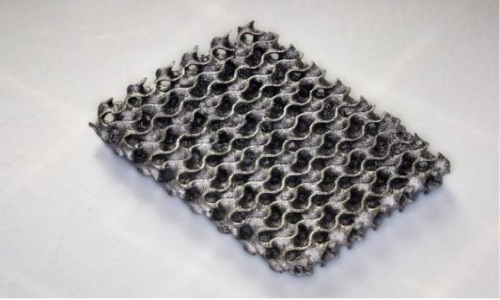


 11:41:58
11:41:58  2025-02-15
2025-02-15  723
723

From the Bronze age to the Industrial Revolution and beyond, the discovery and development of new materials has been a driving force in human history. These novel materials have helped advance technology and shape civilisations.
Today, we are at the beginning of a new era, where artificial intelligence (AI) seems to be in the perfect position to transform the search for useful materials. This looks set to completely change the approach to their investigation, creation and testing.
In ancient times, human civilisations experimented with natural resources to create tools and artifacts. The Bronze age, in the mid-4th millennium BC, was a significant milestone. Bronze, an alloy of copper and tin, led to the development of stronger tools and weapons, as well as advancements in agriculture and construction.
Bronze is often referred to as the first "new material" created by humans. We took different elements and created something new, with better properties than either ingredient and unique qualities. The invention of glass in ancient Mesopotamia around 3,500BC was another groundbreaking moment.
Fast forward to the 20th century and the discovery of plastic polymers, ceramics and superconductors opened new frontiers in technology. Ceramics, known for their durability and heat resistance, became a staple in industries from aerospace to electronics.
Superconductors, materials that can conduct electricity with zero electrical resistance, are already used in maglevs (magnetic levitation trains), particle accelerators and medical devices.
AI enters the fray
Searching for new materials that could help drive the development of the next groundbreaking technologies has previously been a long and expensive process. This has been due to the complexity of many materials at the atomic and molecular levels. Traditional methods are essentially based on trial and error and need specialised equipment and resources.
The inherent uncertainty and risk in material discovery further complicates and lengthens the process. However, advancements in AI, including in a subset of AI called machine learning, are beginning to transform the whole landscape, enabling more efficient and targeted approaches.
In machine learning, mathematical rules called algorithms learn from data to improve at tasks without human intervention.
The main shift is a new methodology based on "generative" AI systems, which can create new content. AI systems can now directly produce novel materials when provided with desired properties and constraints.
Earlier this month, a team at Microsoft published a paper in Nature that introduced a pair of AI tools for the design of inorganic materials (those not based around the element carbon).
These tools play complementary roles in materials discovery. They are called MatterGen and MatterSim. The first one creates new candidate materials, and the second filters and validates them – to ensure they could be made in the real world.
The specific desired properties that can be incorporated through MatterGen include a specific symmetry, or mechanical, electronic and magnetic properties.
Unlike traditional methods that mostly rely on intuition (along with extensive and tedious experimentation), MatterGen can generate thousands of potential materials with specific desired properties in a fraction of the time.
This AI-led approach accelerates the initial stages of material design. It allows researchers to explore a broader range of possibilities and focus on the most promising candidates.
MatterSim applies rigorous computer analysis to predict the stability and viability of these proposed materials. This predictive capability helps filter out theoretical possibilities from physically feasible ones. This ensures that only stable materials move forward in the discovery process.
New tools in the box
At this point, we might wonder, what does a new material, identified through this process, look like? MatterSim is mostly focusing on crystals, or more appropriately unique crystalline structures with a specific arrangement of atoms.
These structures are tailored to meet precise property constraints, making them suitable for various applications. These include high energy batteries, flexible electronics, displays, solar panels or advanced medical implants.
Microsoft's powerful duo, however, is not alone in its quest. Google DeepMind's Graph Networks for Materials Exploration (Gnome) is another tool promising to dramatically speed up the discovery process.
Gnome uses a form of AI that's inspired by the human brain called deep learning. It predicts the stability of new materials, significantly shortening the exploration and discovery phase.
In a paper published in 2023, researchers from Google DeepMind demonstrated that their AI model could identify 2.2 million new stable materials. Some 736 of these have already been experimentally realised.
This is a tenfold increase over previous methods. These materials, many of which were previously unknown to human chemists, have potential applications in clean energy, electronics, and more.
Even if both Google's Gnome and Microsoft's MatterGen are AI-based, they differ in their approaches and, in some ways, provide complementary methodologies. Gnome predicts the stability of new materials by creating variations on existing structures, and it focuses on identifying stable crystalline materials.
MatterGen, on the other hand, employs a generative AI model to directly engineer novel materials based on specific design requirements. It creates material structures by changing elements, positions and periodic lattices (a repeating structure in three dimensions).
The implications of AI-driven material discovery are vast. They could potentially lead to innovations in fields such as energy storage and environmental sustainability. One of the most promising applications is, for example, the development of new batteries.
As the world makes the transition to renewable energy sources, the demand for efficient, long lasting batteries has grown and will continue to do so. AI tools can help researchers design and identify new materials able to support higher energy densities, faster charging times and longer lifespans.
Beyond energy storage, new materials can be used to design new medical devices, implants and even drug delivery systems. This could improve patient outcomes and advance medical treatments.
In aerospace, lightweight, durable materials could enhance the performance and safety of aircraft and spacecraft. Meanwhile, new materials for water purification, carbon capture, and waste management could address pressing environmental challenges.
Reality Of Islam |
|

Poisoning i

Water may s

"It is

The process
 9:3:43
9:3:43
 2018-11-05
2018-11-05
10 benefits of Marriage in Islam
 7:5:22
7:5:22
 2019-04-08
2019-04-08
benefits of reciting surat yunus, hud &
 9:45:7
9:45:7
 2018-12-24
2018-12-24
advantages & disadvantages of divorce
 11:35:12
11:35:12
 2018-06-10
2018-06-10
 6:0:51
6:0:51
 2018-10-16
2018-10-16
 10:55:53
10:55:53
 2022-06-13
2022-06-13
 7:32:24
7:32:24
 2022-02-14
2022-02-14
 9:42:16
9:42:16
 2022-10-19
2022-10-19
 4:26:43
4:26:43
 2022-02-21
2022-02-21
 1:34:8
1:34:8
 2022-02-01
2022-02-01
 6:28:21
6:28:21
 2022-12-20
2022-12-20
 8:30:23
8:30:23
 2022-03-03
2022-03-03
 5:41:46
5:41:46
 2023-03-18
2023-03-18
| LATEST |